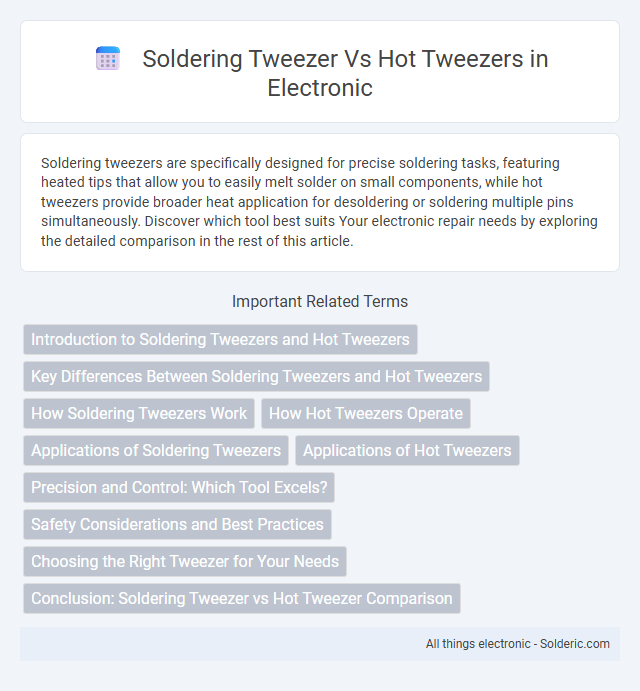Soldering tweezers are specifically designed for precise soldering tasks, featuring heated tips that allow you to easily melt solder on small components, while hot tweezers provide broader heat application for desoldering or soldering multiple pins simultaneously. Discover which tool best suits Your electronic repair needs by exploring the detailed comparison in the rest of this article.
Comparison Table
| Feature | Soldering Tweezer | Hot Tweezers |
|---|---|---|
| Function | Heats two points simultaneously for soldering small components | Designed for precise heating and removal of SMD components |
| Heating Method | Electric heating elements in tweezer tips | Electric heating with rapid temperature control |
| Temperature Control | Basic or no control | Digital or adjustable precise control |
| Use Cases | Soldering and desoldering fine wires and parts | Specialized for SMD components like resistors and ICs |
| Precision | Moderate precision | High precision targeting small components |
| Price Range | Affordable to mid-range | Mid-range to premium |
| Common Brands | Weller, Hakko | Atten, Quick, JBC |
Introduction to Soldering Tweezers and Hot Tweezers
Soldering tweezers are precision tools designed for desoldering small surface-mount devices by applying heat directly to component leads using heated tips. Hot tweezers operate similarly but typically feature adjustable temperature control and enhanced insulation, providing more consistent heat distribution for delicate electronics work. Both tools improve efficiency in removing and placing components, especially in PCB repair and rework tasks.
Key Differences Between Soldering Tweezers and Hot Tweezers
Soldering tweezers use two heated tips to simultaneously solder or desolder small components, ideal for precision work on surface-mount devices, while hot tweezers provide controlled heat delivery primarily for heating and removing components without direct soldering. The key difference lies in their function: soldering tweezers actively melt solder to join or separate parts, whereas hot tweezers focus on heating components evenly to facilitate removal or placement. Choosing the right tool enhances Your efficiency in electronics repair or assembly by matching the device's specific heating and handling requirements.
How Soldering Tweezers Work
Soldering tweezers operate by heating two metal arms simultaneously, allowing precise melting and removal of small electronic components, such as surface-mount devices (SMDs), from circuit boards. The tweezers' tips are electrically heated through resistance, reaching controlled temperatures that facilitate efficient solder joint melting without damaging delicate parts. This dual-tip heating mechanism ensures accurate soldering and desoldering, making soldering tweezers essential for fine electronics repair and assembly.
How Hot Tweezers Operate
Hot tweezers operate by integrating a heating element directly into the tweezer tips, enabling precise temperature control for soldering or desoldering components on circuit boards. Temperature sensors and adjustable controllers maintain consistent heat, ensuring efficient melting of solder without damaging sensitive electronic parts. This targeted heat application improves accuracy and reduces thermal stress compared to traditional soldering tweezers that require external heating sources.
Applications of Soldering Tweezers
Soldering tweezers are primarily used for precision work in electronics for soldering and desoldering surface-mount devices (SMDs) such as resistors, capacitors, and ICs on printed circuit boards (PCBs). These tools provide accurate heat application on small components, making them ideal for repair, prototyping, and rework tasks in semiconductor and microelectronics industries. Their design allows simultaneous heating of dual terminals, improving efficiency and reducing the risk of damage compared to traditional soldering irons.
Applications of Hot Tweezers
Hot tweezers are specifically designed for surface mount device (SMD) rework and repair, enabling precise heating and removal of small components like resistors, capacitors, and ICs without damaging adjacent parts. These tools are essential in electronics manufacturing and prototyping for tasks requiring rapid and accurate thermal application. Their dual-tip heating elements allow simultaneous heating on both sides of components, increasing efficiency in soldering and desoldering delicate parts.
Precision and Control: Which Tool Excels?
Soldering tweezers provide superior precision and control for delicate electronic components due to their fine, pointed tips and ergonomic design, allowing you to manipulate small parts accurately. Hot tweezers, equipped with integrated heating elements, excel in uniformly applying heat to surface-mounted devices, but may sacrifice some degree of fine control compared to soldering tweezers. For tasks requiring meticulous handling and exact placement, soldering tweezers outperform hot tweezers in precision and control.
Safety Considerations and Best Practices
Soldering tweezers provide precise temperature control, reducing the risk of overheating components, while hot tweezers offer faster heat transfer but require careful handling to avoid burns. To ensure your safety, always use heat-resistant gloves and work in a well-ventilated area to minimize exposure to fumes. Regularly inspect your tools for insulation damage and avoid applying excessive pressure to prevent accidents during delicate tasks.
Choosing the Right Tweezer for Your Needs
When selecting between soldering tweezers and hot tweezers, consider the specific task requirements and component sizes you'll be working with. Soldering tweezers excel in precision for small surface mount devices, providing direct heat to two points simultaneously, while hot tweezers offer adjustable temperature control for delicate components and thermal-sensitive operations. Your choice should prioritize ease of use, temperature accuracy, and the compatibility of the tool with your soldering projects.
Conclusion: Soldering Tweezer vs Hot Tweezer Comparison
Soldering tweezers offer precise temperature control and are ideal for delicate surface mount device (SMD) work, providing targeted heat for efficient soldering and desoldering. Hot tweezers, on the other hand, deliver consistent heating across both tips simultaneously, making them better suited for larger components or repetitive tasks. Your choice should depend on the specific electronics applications and precision requirements you encounter.
Soldering tweezer vs hot tweezers Infographic

 solderic.com
solderic.com